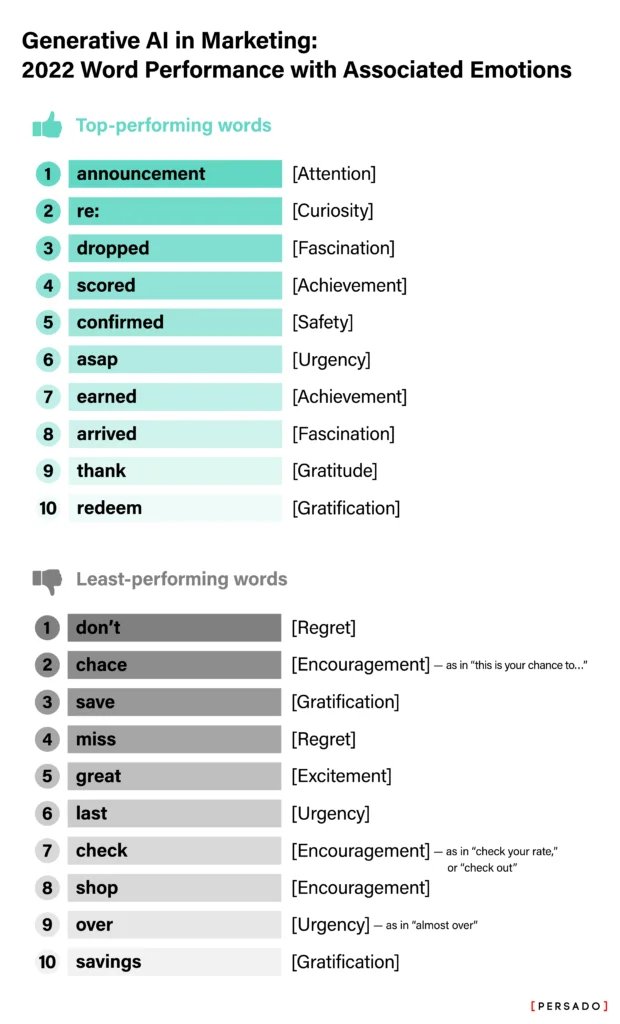In marketing, the words brands use to connect with and convert customers evoke certain emotions. Based on these emotions, they also bring forth certain actions or lack of actions among consumers. But, which words actually spark conversions, clicks, and conversations? Which emotions and sentiments do today’s customers respond best to? Which are no longer effective? How can using Generative AI in Marketing help enterprise brands identify which words to use with which audience?
In order to answer the key questions top brands constantly ask, the Persado Content Intelligence team analyzed results from more than 21.6 billion consumer impressions (email messages sent), encompassing the 8.6 billion message variations that appeared in our customers’ campaign experiments from January 1, 2022 to December 15, 2022. Messages spanned industries from travel to finance, encompassing many of the world’s largest retail brands.
Persado identified the 10 best-performing and lowest-performing words based on the click through rates (CTRs) of emails sent to consumers across various industries and segments. The knowledge base in the Persado Motivation AI Platform tags individual words and word combinations to the emotion they evoke (i.e. gratitude, achievement, regret, etc.).
The findings discovered using Generative AI in Marketing should reshape the ways B2C marketers approach their customer audiences in the coming year.

Note: Words are tagged to the most likely associated emotion.
Key Actions for B2C Marketers
What changes can marketing teams make based on these findings?*
If the lessons from 2022 hold for 2023, here are some actions marketers can take right now to better connect with customers and motivate action with the help of Generative AI in Marketing.
- FOMO is a No No: Marketers should stay away from phrases such as “last chance” or “don’t miss out”. The data makes it clear that modern consumers don’t respond well to ultimatums, regret, or a sense of scarcity. While it may be tempting to turn to FOMO, or fear of missing out, on the last days of a campaign or when inventory is running low, terms like “ASAP” or “redeem” work better than words like “last” when you need to convey a sense of urgency. ”Last” implies an ultimatum, which can be negative/de-motivating. ASAP, in contrast, grabs the customers’ attention and signals immediacy in a less time-restrictive way.
- Avoid Added Effort: This study found no imperatives in the top-performing words. In contrast, there were four imperatives, commands, or requests among the least-performing words. Imperatives create the perception that the customer will have to put in more effort, which doesn’t evoke desired actions such as clicks, conversions, etc.
- Highlight Long-term Value: The modern customer isn’t looking for the latest deal. They are seeking something more concrete and specific. As inflation and uncertainty loom, they want to make purchases that give them a long-term sense of satisfaction and value, not a quick fix that’s only going to provide a short-term benefit.
- Attitude of Gratitude: Customers responded well to brands that expressed their appreciation for them and their business. While promoting a quick sale can come off as fleeting, showing thankfulness is an important part of adding value and driving an ongoing relationship with customers.
Interesting Insight: Most of the top-performing words are in the past tense (i.e. dropped, confirmed, scored, arrived.). This shows that customers were more engaged when messages promised something tangible.
Rather than ask your customer to take an action, let them know it’s already done on their behalf! The least performing words put the onus on the consumer to take an action, but consumers don’t want to expend effort. Looking at the top performing words, I’m reminded to make action easy for customers. Reassure them that the hard work has been completed for them—deals are confirmed, new products have arrived, points are already earned. There’s nothing like a sure bet to motivate engagement. Of course, added thanks is always welcomed.
Lisa Spira, VP of Content Intelligence at Persado
Overall, emotions work. However, there isn’t a single emotion that works best all the time. Context is everything and every audience is different. Messaging that works for a luxury brand may not be effective for a big box store. Sentiment that works in financial services may not resonate with a retail audience.
Segmentation of your audiences is also a significant aspect of the modern marketing strategy as most messaging isn’t relevant to your entire audience. One-size-fits-all marketing has long been obsolete. Top brands take a more personalized approach by segmenting their audience into categories by behavior, geography, and other demographics/data and run different campaigns unique to each audience to achieve optimal results. So it’s important for marketers to continue to experiment and test different messaging variations across many segments. For more on segmenting your marketing audiences, check out these five types of market segmentation and how to use them.
To learn how world-class brands like Chase, Kate Spade, and Marks & Spencer accelerate growth using Generative AI to achieve true language personalization at scale, talk to an expert.
*Recommendations are based on analysis of current consumer engagement patterns and are always subject to change.
The post How Generative AI in Marketing Drives Business Results: Winners and Losers from Email Performance Data appeared first on Persado.
